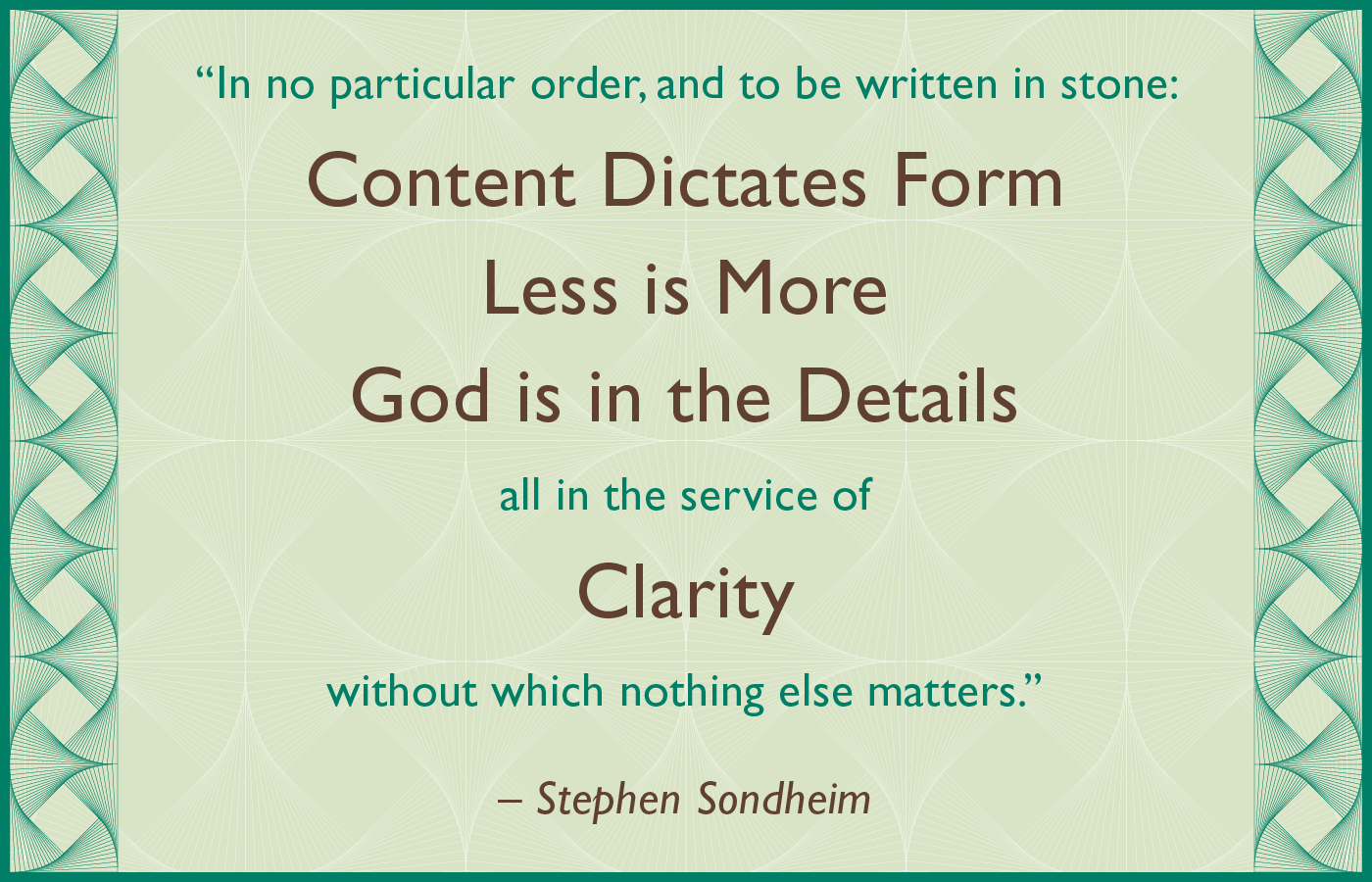Writing musicals for young people
/As the old adage goes, “Musicals aren’t written, they’re rewritten”. And so, over the last few months, Emily and I have been reworking aspects of our 2014 musical Return to Aesop.
Written for our Youth Summer School that year, we wrote the original script and score to a tight deadline, freezing the show earlier than we might have liked to. Set against the backdrop of some of Aesop's well-loved fables including ‘The Hare & the Tortoise’ and ‘The Boy Who Cried Wolf’, this fun, family musical is now being redeveloped for the schools and youth theatre market.
It’s a joy to revisit it now, older, perhaps wiser, and definitely less attached to our original work. Having the freedom to ruthlessly scrap what came before will, we hope, lead to a more succinct and publishable version of the show that we can introduce to young performers across the land. Along with our experience of directing youth productions, all this got us thinking…
What are the Top 10 ingredients for writing and producing musicals for young performers?
1 - Don’t Patronise
Young people aren’t stupid. Every single day they’re saturated in news, the media, celebrities, pop culture, the good and the bad of the world, so don’t patronise by writing simple dialogue, music or lyrics or dumbing down your ideas. Young people are smart. They can handle tricky.
Just look at the musical Matilda; a song like ‘Quiet’ does anything but patronise.
2 - Layers
If you’re a fan of Shrek, you’ll know that ogres are like onions; they have layers. Well, musicals are like ogres. They might seem big and scary, but they’re layered.. and have feelings.
Let’s say you have a cast of 9 - 18 year olds performing your show, that’s a lot of different tastes to cater for. Those performers then come with an audience; their younger siblings, their parents, their grandparents, their friends. You’re not just writing a show for the sensibilities of the 9 - 18 year olds performing it, but for the many ages watching it. Put in something for everyone; light-hearted slapstick sits well alongside political satire. Remember it’s not just children who’ll root for the former and the adults the latter, either…
3 - Keep the Story Simple
Source: medium.com
“Less is more”, so Stephen Sondheim writes in his list of principles in the Finishing the Hat anthology. While you don’t want to patronise, the key to all writing is keeping the story simple. Something we’re ironing out with Return to Aesop are the kinks in our characters’ backstories. If you can’t sum the story up in one swift elevator pitch, remove a few of the floors the elevator stops at.
One way to do this is by always asking yourself…
4 - What does the protagonist want?
If you can’t answer this question, revise the plot.
The call to action for your protagonist(s) must be clear from the off. It’s what they’ll remind the audience of in their iconic ‘I Want’ song; the song that breaks down their motivation to achieve a goal, thus providing the subsequent traffic of the play.
Think ‘Part of Your World’ from The Little Mermaid (Ariel literally sings ‘I want’ over and over!), ‘The Wizard and I’ ‘from Wicked, or ‘My Shot’ from Hamilton.
We recommend Julian Woolford’s excellent book How Musicals Work for a great breakdown on how to establish story and character.
5 - Gender Flexible
It’s not uncommon for girls to outnumber boys in youth theatre productions. Alternatively, a boys’ school or a group of Girl Guides might want to stage your musical, providing directors with the (we think fun!) challenge of staging a musical with a single sex cast.
Keeping the gender of your chorus and principal cast somewhat androgynous can provide fewer challenges when it comes to casting a musical. For years we’ve seen girls play the Artful Dodger or Peter Pan, but I’ve never seen a boy play Annie, ‘though see no reason why he couldn’t. Unless a character’s gender is completely integral to the plot, offering some flexibility might make your work more marketable and allow the actors and audience to enter into new discussions.
6 - Avoid Romantic Love
Anna & ELSA, the ultimate love story.
Source: frozen.disney.com
I’m a firm believer that love is what makes the world go round, perhaps the very meaning of life itself. However, love comes in all sorts of forms; sibling love, friendship, parental love, love for a hobby or pet, there’s a lot of love to go around!
Young people have enough going on developing their sexual identity and feelings off stage, yet many theatre kids have their first kiss on stage in what can be an awkward moment for everyone involved. Think outside the box when it comes to the love stories you choose to tell.
7 - Workshop It
Put your ideas to the test before you put them on stage and use the voices of the people you’re writing for.
If you don’t already have a relationship with a youth theatre group, find some young performers to try out your songs and scenes. Where do the songs sit in their vocal placement? Does it work for a newly broken voice, for example? Do they find it funny? Is it easy to pick up? Having the opportunity to direct our own shows as part of our Summer School was invaluable; we knew what challenges then presented themselves in staging the show and were able to gauge what material we might need to rework going forward.
8 - Director’s Guide
So you’ve written a musical and it’s ready to market to young performers? Well done!
Anna & Emily directing - Photo by Rebecca Pitt
If you want your show to reach a wide audience, we recommend putting together a Director’s Guide. Not all youth productions are staged by experienced directors with big budgets in grand theatres. Far more are produced on a shoe string in a school hall, by an already over-worked teacher who has been tasked with staging the school musical. Help them out!
Providing a guide with ideas on how to stage a tricky scene with everyone on stage, or offering some simple set and costume ideas can make the task seem less daunting, and might lead to more people buying your show. Make it clear that these ideas can be ignored, of course! I’d love to see one of our musicals reimagined on pogo-sticks and set on Saturn.
9 - Backing Tracks
I love live music more than anything else, but sometimes staging an amateur musical with a live band is more trouble than it’s worth. The cost of good sound production alone can be enough of a headache, not to mention finding capable musicians, many of whom might prefer to perform in the cast. One way around this is to provide backing tracks to sell with the rights to your show. They don’t need to be fully orchestrated, but are a great way to ensure your score is presented to the highest quality, regardless of who is putting on the production. We thoroughly recommend including…
10 - Guide Vocals
You don’t want to turn away performers who can sing but can’t read music. In the absence of a cast recording, providing guide vocals that break down solos and harmonies can be an invaluable teaching and rehearsal resource. While the production of these tracks will cost you a little extra, it might result in a more produceable musical, so it’s definitely worth investing in.
Have you any other tips for writing and producing musicals for young people? Drop a comment below!
- Anna
Return to Aesop was one of three musicals written for the Starling Arts Summer School. Prior to this, Anna had written another show for young performers and, during our Summer School, we also produced Broadway Junior productions of Honk! JR, Disney’s Beauty & the Beast JR and Seussical JR.
Find out more about our musicals on the Garsin & Shields website.





